
A guide to led bulbs and other sources of light for egg producers
Understanding poultry light biology and environment
Light is critical for egg production and pullet growth. Domestic poultry see and respond to a different range of light color spectrum and have different spectral intensity responses than humans. While humans respond to light from around 400–750 nm, chickens can see UV-A light (315–400 nm) in addition to 400–750 nm. Additionally, the magnitude of sensitivity for red and blue spectra is much higher for chickens with additional peaks of light sensitivity around 480 nm and 630 nm.
Understanding the difference between Lux and Clux
While peak lux can be assessed at any wavelength, the International Commission on Illumination (CIE) standard for measuring light intensity is set at the peak human response of 550–560 nm. Chickens have three photopic spectral peaks, so additional calculations utilizing the poultry-specific peaks are required to measure these clux. Depending on the light source and peak spectrum, clux can be up to 50% or higher in light intensity than lux.
Understanding the difference between lux and clux provides a more accurate selection of light bulbs for the producer and allows them to recognize the limitations of traditional light meters. While using a traditional light meter can be an indicator of light intensity in a house, there will always be a difference between lux and clux.
Poultry light biology
Chickens detect light not only through the retinal cone receptors in the eyes, but also via extra retinal photoreceptors in the pineal gland and the hypothalamic gland. The response to light controls the circadian rhythm, a 24-hour cycle in the bird’s hormonal and behavioural aspects. Humans are trichromatic and have retinal cones that can determine red, green and blue. Chickens are tetrachromatic, with an additional double cone whose function may be related to tracking movement.
In poultry, red light is vital for stimulating sexual maturity and egg production. Birds exposed to red light versus blue, green or white light consistently have higher egg production than the other color groups. Red light is able to penetrate the skull to stimulate the extra retinal photoreceptors. Red light (around 650 nm) penetrates the skull and brain (hypothalamus) four to 50 times more efficiently than blue, green and yellow-orange light. The hypothalamus is important in regulating the production of hormones important for egg production.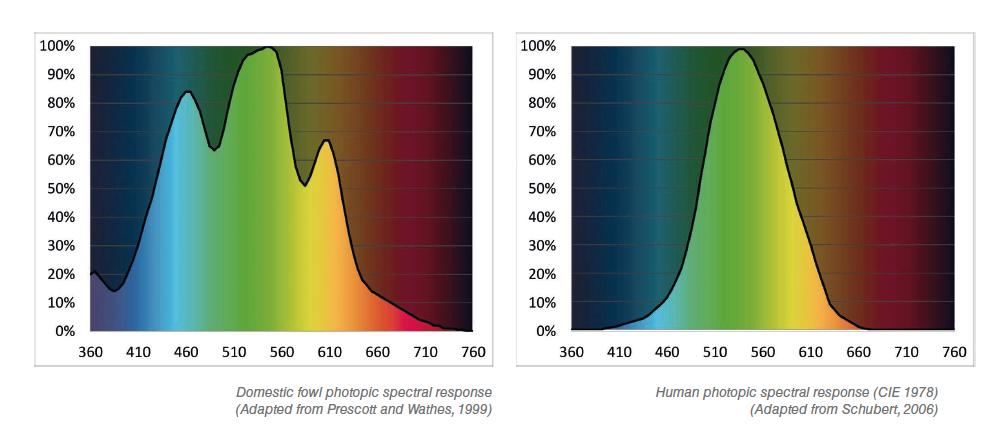 Light environments
Light environments
Chickens are affected by the duration, intensity and spectrum of light. Light can be utilized as a management tool to help optimize pullet growth, age of sexual maturity, egg weight and egg production in laying hens in a variety of environments.
Duration – As a general rule, decreasing light duration is utilized for growing pullets and increasing light duration is used to stimulate layers. Light stimulation (usually an increase of as little as one hour) has an immediate effect on the production of reproductive hormones. The standard level of light for maximum production is 16 hours. It is ideal to reach 16 hours of light by 30–35 weeks to help prolong peak production.
Spectrum – Understanding the color spectrum given off by a light source will assist producers in selecting a light bulb which can deliver the proper amounts of red, green and blue light. Light bulb color can be expressed in degrees Kelvin (K) and color rendering index (CRI).
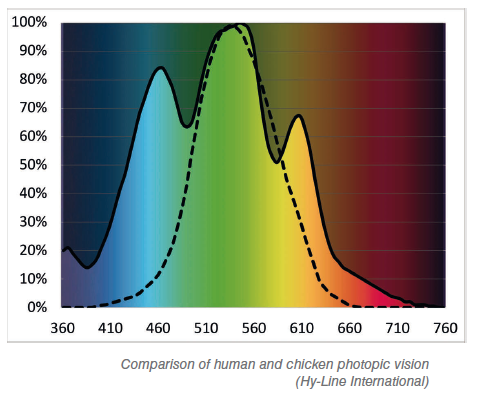 However, neither of these measurements expresses the spectral peak intensity in the red, green, and blue spectra that are important for poultry growth and production. Research on broilers has shown that blue and green LED lights enhance growth. Research on layer pullets indicates that LED lights with a greater portion of blue and green spectra result in better body weights and uniformity compared to incandescent bulbs, although more data is needed (Settar, unpublished data). Overall, pullets may be reared with warm or cool lights, but laying hens should have lights with a sufficient red spectrum3 (2700K–3000K). Light bulb manufacturers usually provide information on degrees Kelvin, or a spectrometer can be used.
However, neither of these measurements expresses the spectral peak intensity in the red, green, and blue spectra that are important for poultry growth and production. Research on broilers has shown that blue and green LED lights enhance growth. Research on layer pullets indicates that LED lights with a greater portion of blue and green spectra result in better body weights and uniformity compared to incandescent bulbs, although more data is needed (Settar, unpublished data). Overall, pullets may be reared with warm or cool lights, but laying hens should have lights with a sufficient red spectrum3 (2700K–3000K). Light bulb manufacturers usually provide information on degrees Kelvin, or a spectrometer can be used.
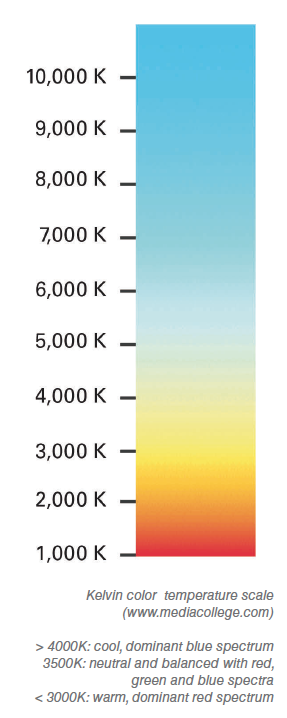 Intensity – Light intensity, measured in lux, clux or foot candles, is also important for poultry production. In general, light intensity below 5 lux is too dark to stimulate proper growth and production, while higher light intensity (above 50 lux) may cause nervousness and aberrant behaviour.
Intensity – Light intensity, measured in lux, clux or foot candles, is also important for poultry production. In general, light intensity below 5 lux is too dark to stimulate proper growth and production, while higher light intensity (above 50 lux) may cause nervousness and aberrant behaviour.
The standard recommendation for growing pullets is to brood for 2 to 3 weeks at 30–50 lux, and then dim to 10–15 lux until 14 weeks. Two weeks prior to the transfer, gradually increase the light intensity to match the levels in the layer house. Laying hens should be kept at an average of 30 lux at the level of the feed trough.
Maintaining uniform light intensity in a modern poultry facility can be difficult. To measure light distribution in conventional cage or colony houses with manure belts, it is ideal to take a measurement at the feed trough every 25 cm (or 1 foot) between lights and at every level. This will typically require between 30 and 100 light readings to accurately assess the light distribution.
In floor houses, measure at the wall, at feeder and drinker lines beneath the lights and 2–3 times in between lights for a total of 10 to 50 measurements.
In open-sided houses, use window shades and curtains to prevent direct sunlight from coming into the house. Even with these interventions, the light intensity in open houses can easily reach above 1000 lux.
Understanding light spectrum, chromaticity and color rendering index
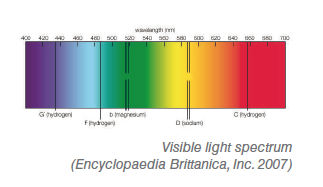 Light is the visible part of the electromagnetic spectrum. Understanding the impact light spectrum has on poultry production is critical for selecting the right bulb.
Light is the visible part of the electromagnetic spectrum. Understanding the impact light spectrum has on poultry production is critical for selecting the right bulb.
Chromaticity or Correlated Color Temperature (CCT)
Chromaticity measures the relative warmness or coolness of light, and is expressed in degrees Kelvin (K). While originally developed for incandescent lights, chromaticity gives an estimation of the dominant spectra in a given light source; however, chromaticity does not give information about the relative color peaks or balance of spectrum.
Color Rendering Index (CRI)
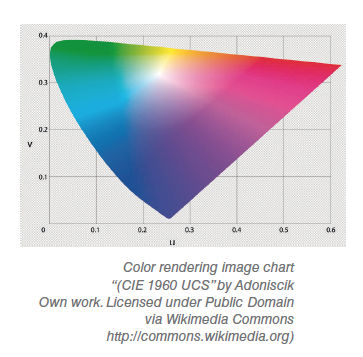 The color-rendering index measures how an artificial light source displays the color of an object compared to the color of that object in natural light. This measure is important for human perception and comfort in a light environment. CRI is measured on a scale of 0–100, with 100 being the closest to natural light. The higher the CRI, the closer the artificial light source is to displaying colors accurately. Overall, CRI differences less than 5 (i.e. 80 to 84) are not noticeable to the human eye.
The color-rendering index measures how an artificial light source displays the color of an object compared to the color of that object in natural light. This measure is important for human perception and comfort in a light environment. CRI is measured on a scale of 0–100, with 100 being the closest to natural light. The higher the CRI, the closer the artificial light source is to displaying colors accurately. Overall, CRI differences less than 5 (i.e. 80 to 84) are not noticeable to the human eye.
The CRI system was originally developed for incandescent lights and does not correlate as well with compact fluorescent light (CFL) or LED lights. A general scale for evaluating lights using CRI values is:
< 50: Poor
50–70: Fair
70–80: Good
80–100: Best
Lighting Terminology
Photoperiod: Duration of light in a 24-hour period.
Luminous flux: Total perceived power of light produced by the light source. The unit is Lumen (lm). The prefix “luminous” always indicates that the measured unit is adjusted by luminosity function or human eye sensitivity. The prefix “Visible Radiant” or “Radiant” indicates that the measured unit is in “raw” form (for example – total photons) independent of particular visual system.
Luminous intensity: Power emitted by a light source into directional solid angle. The unit is Candela (cd).
Illuminance: Total luminous flux on a surface. The unit is lux (lx) and the non-metric unit is foot-candle (fc).
Clux or galliux: Total radiant flux incident on a surface adjusted by color (measured in nanometer [nm]) sensitivity curve of chickens (Gallus domesticus). The unit is Clux (cLx).
Visible light spectrum: Portion of the electromagnetic spectrum that is visible to the human eye or animal eye. Spectrum wavelength (nm) determines the color of the light (430nm to 490nm is blue color).
Ultraviolet (UV): Electromagnetic radiation from 10 nm to 400 nm.
Infrared light (IR): Electromagnetic radiation from 700 nm to 1,000,000 nm (1 mm).
Photopic spectral sensitivity: Color sensitivity or sensitivity to light under bright conditions.
Color rendering index: A measure of the ability of a light source to reveal the colors of an object in comparison to ideal light source. Incandescent light can be considered ideal light source.
Chromaticity: The objective measurement of the color of a light source independent of the illuminance.
Photos are by courtesy of Hy-Line International

















